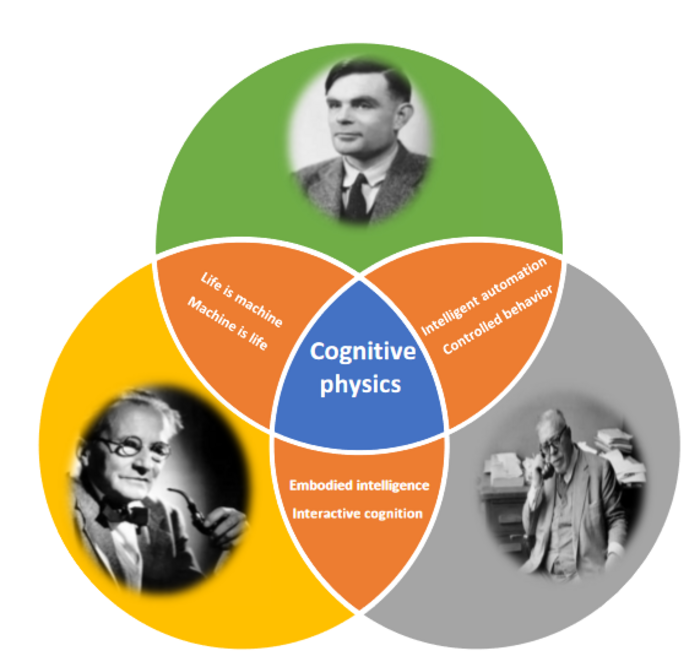Deyi Li from the Chinese Association for Artificial Intelligence believes that humans and machines have a mutually beneficial relationship. His paper on machine intelligence, which was published Feb. 15 in Intelligent Computing, a Science Partner Journal, builds on five groundbreaking works by Schrödinger, the father of quantum mechanics, Turing, the father of artificial intelligence, and Wiener, the father of cybernetics.

Credit: Deyi Li.
Deyi Li from the Chinese Association for Artificial Intelligence believes that humans and machines have a mutually beneficial relationship. His paper on machine intelligence, which was published Feb. 15 in Intelligent Computing, a Science Partner Journal, builds on five groundbreaking works by Schrödinger, the father of quantum mechanics, Turing, the father of artificial intelligence, and Wiener, the father of cybernetics.
Schrödinger and beyond: Machines can think and interact with the world as time goes by.
Inspired by Schrödinger’s book “What is Life? The Physical Aspect of the Living Cell,” Li believes that machines can be considered living things. That is, like humans, they decrease the amount of entropy or disorder in their environment through their interactions with the world.
The machines of the agricultural age and the industrial age existed only at the physical level, but now, in the age of intelligence, machines consist of four elements at two different levels: matter and energy at the physical level, and structure and time at the cognitive level. “The machine can be the carrier of thought, and time is the foundation of machine cognition,” Li explained.
Turing and beyond: Machines can think, but can they learn?
In 1936, Turing published what has been called the most influential mathematics paper, establishing the idea of a universal computing machine able to perform any conceivable computation. Such hypothetical computers are called Turing machines. His 1950 paper “Computing Machinery and Intelligence” introduced what is now known as the Turing test for measuring machine intelligence, sparking a debate over whether machines can think. A proponent of thinking machines, Turing believed that a “child machine” could be educated and eventually achieve an adult level of intelligence.
However, given that cognition is only one part of the learning process, Li pointed out two limitations of Turing’s model in achieving better machine intelligence: First, the machine’s cognition is disconnected from its environment rather than connected to it. This shortcoming has also been highlighted in a paper by Michael Woodridge titled “What Is Missing from Contemporary AI? The World.” Second, the machine’s cognition is disconnected from memory and thus cannot draw on memories of past experiences. As a result, Li defines intelligence as the ability to engage in learning, the goal of which is to be able to “explain and solve actual problems.”
Wiener and beyond: Machines have behavioral intelligence.
In 1948, Wiener published a book that served as the foundation of the field of cybernetics, the study of control and communication within and between living organisms, machines and organizations. In the wake of the success of the book, he published another, focusing on the problems of cybernetics from the perspective of sociology, suggesting ways for humans and machines to communicate and interact harmoniously.
According to Li, machines follow a control pattern similar to the human nervous system. Humans provide missions and behavioral features to machines, which must then run a complex behavior cycle regulated by a reward and punishment function to improve their abilities of perception, cognition, behavior, interaction, learning and growth. Through iteration and interaction, the short-term memory, working memory and long-term memory of the machines change, embodying intelligence through automatic control. “In essence, control is the use of negative feedback to reduce entropy and ensure the stability of the embodied behavioral intelligence of a machine,” Li concluded.
The strength of contemporary machines is deep learning, which still requires human input, but leverages the ability of devices to use brute force methods of solving problems with insights gleaned directly from big data.
A joint future: from learning to creating
Machine intelligence cannot work in isolation; it requires human interaction. Furthermore, machine intelligence is inseparable from language, because humans use programming languages to control machine behavior.
The impressive performance of ChatGPT, a chatbot showcasing recent advances in natural language processing, proves that machines are now capable of internalizing human language patterns and producing appropriate example texts, given the appropriate context and goal. Since AI-generated texts are increasingly indistinguishable from human-written texts, some are saying that AI writing tools have passed the Turing test. Such declarations provoke both admiration and alarm.
Li is among the optimists who envision artificial intelligence in a natural balance with human civilization. He believes, from a physics perspective, that cognition is based on a combination of matter, energy, structure and time, which he calls “hard-structured ware,” and expressed through information, which he calls “soft-structured ware.” He concludes that humans and machines can interact through multiple channels and modes to gain wisdom and intelligence, respectively. Despite their different endowments in thinking and creativity, this interaction allows humans and machines to benefit from each other’s strengths.
Journal
Intelligent Computing
DOI
10.34133/icomputing.0009
Article Title
Cognitive Physics—The Enlightenment by Schrödinger, Turing, and Wiener and Beyond
Article Publication Date
15-Feb-2023




